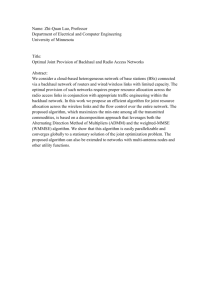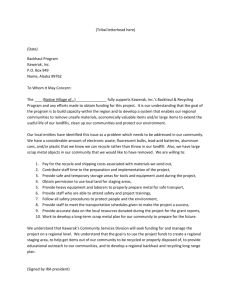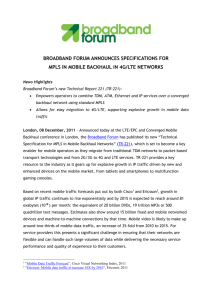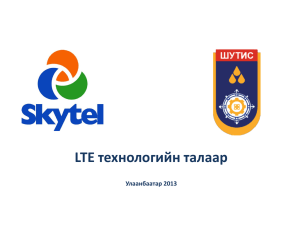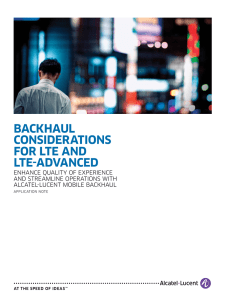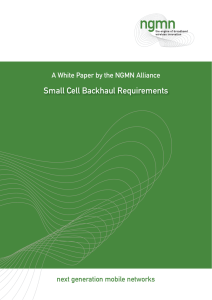LTEHaul: SDN-based mobile backhaul TextStart By Sun Xinwu
advertisement
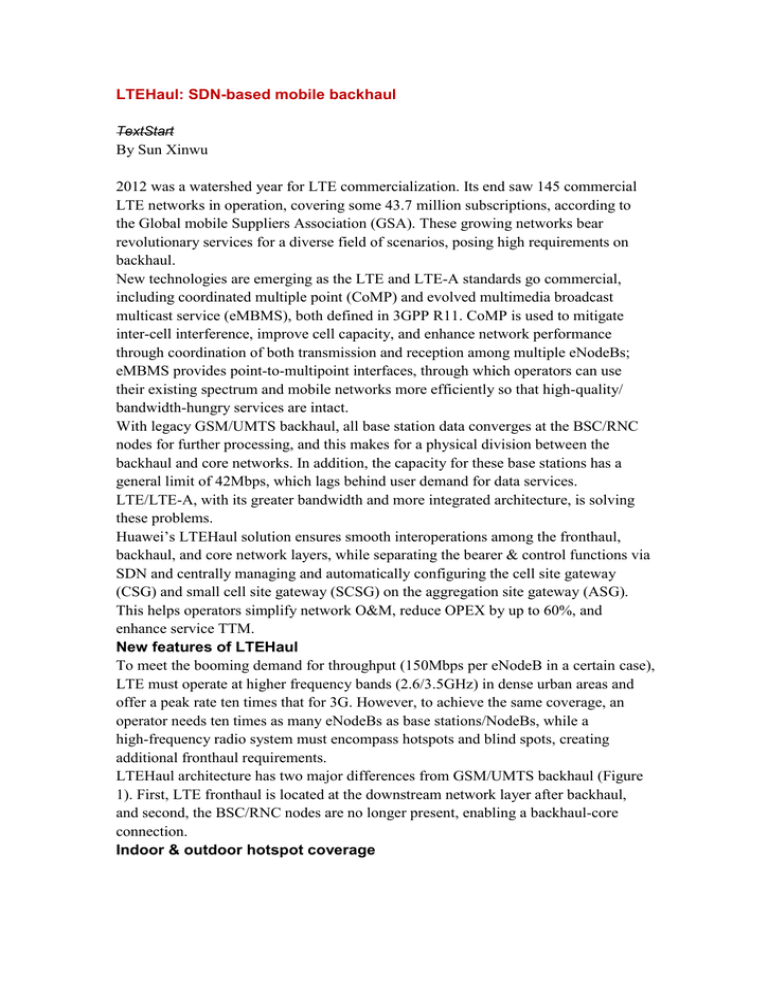
LTEHaul: SDN-based mobile backhaul TextStart By Sun Xinwu 2012 was a watershed year for LTE commercialization. Its end saw 145 commercial LTE networks in operation, covering some 43.7 million subscriptions, according to the Global mobile Suppliers Association (GSA). These growing networks bear revolutionary services for a diverse field of scenarios, posing high requirements on backhaul. New technologies are emerging as the LTE and LTE-A standards go commercial, including coordinated multiple point (CoMP) and evolved multimedia broadcast multicast service (eMBMS), both defined in 3GPP R11. CoMP is used to mitigate inter-cell interference, improve cell capacity, and enhance network performance through coordination of both transmission and reception among multiple eNodeBs; eMBMS provides point-to-multipoint interfaces, through which operators can use their existing spectrum and mobile networks more efficiently so that high-quality/ bandwidth-hungry services are intact. With legacy GSM/UMTS backhaul, all base station data converges at the BSC/RNC nodes for further processing, and this makes for a physical division between the backhaul and core networks. In addition, the capacity for these base stations has a general limit of 42Mbps, which lags behind user demand for data services. LTE/LTE-A, with its greater bandwidth and more integrated architecture, is solving these problems. Huawei’s LTEHaul solution ensures smooth interoperations among the fronthaul, backhaul, and core network layers, while separating the bearer & control functions via SDN and centrally managing and automatically configuring the cell site gateway (CSG) and small cell site gateway (SCSG) on the aggregation site gateway (ASG). This helps operators simplify network O&M, reduce OPEX by up to 60%, and enhance service TTM. New features of LTEHaul To meet the booming demand for throughput (150Mbps per eNodeB in a certain case), LTE must operate at higher frequency bands (2.6/3.5GHz) in dense urban areas and offer a peak rate ten times that for 3G. However, to achieve the same coverage, an operator needs ten times as many eNodeBs as base stations/NodeBs, while a high-frequency radio system must encompass hotspots and blind spots, creating additional fronthaul requirements. LTEHaul architecture has two major differences from GSM/UMTS backhaul (Figure 1). First, LTE fronthaul is located at the downstream network layer after backhaul, and second, the BSC/RNC nodes are no longer present, enabling a backhaul-core connection. Indoor & outdoor hotspot coverage With GSM/UMTS, fronthaul is normally located at a lower network layer, but with LTEHaul, it is the last mile, covering indoor (Wi-Fi & small cell) and outdoor hotspots. Wi-Fi indoor fronthaul is typically required at mobile oases (hotels, cafes, airports). Supplemented by GSM/UMTS, this access scenario is characterized by low mobility, a large amount of data, and no voice. As access media vary (P2P fiber/copper/PON) and power supply for RRUs is required, the fronthaul in this case must be media-agnostic and enable Power over Ethernet (PoE) functionality. Furthermore, bearer devices should be small, easy-to-install, energy efficient, and maintenance free, so that OPEX is held in check. Small cell indoor fronthaul is primarily used for shopping malls. It is characterized by high mobility and a large amount of voice and data over a broad area. To ensure quick service provisioning and high-quality service experience, the fronthaul network should allow remote RRU power supply, hierarchical quality of service (HQoS), and access by any medium, while bearer devices should be easy-to-install, maintenance-free, and plug-and-play to reduce costs. Small cell outdoor fronthaul applies to crowded outdoor scenarios, such as bustling streets, city plazas, and open-air cafes. It is characterized by heavy voice and data traffic, and its challenges include site acquisition and access diversity. The access media in place must be leveraged, and bearer devices should be ecofriendly, have a minimal footprint (walls and poles work well), and feature surge protection and resistance to the elements. If fixed access is unavailable, full outdoor microwave can be used, though it should be deployed (with parabolic antennas for rapid focusing) and commissioned (USB configuration) quickly, and be easy to maintain. Converged CSG backhaul For a GSM/UMTS network, a cell site gateway (CSG) will serve only one base station, while an LTE CSG aggregates traffic from various hotspots. Taken on its own terms, this sounds great, but it calls for measures that ensure greater system reliability, including carrier-grade 1+1 10GE ring protection, 1+1 backup for system control units, and multi-node failure protection. VoLTE’s commercial maturation is accelerating GSM/UMTS spectrum refarming, and this poses a challenge to network scalability. For a blade RRU solution that supports multi-band & multi-mode refarming (seven bands, four modes), the CSG nodes must have six service slots and a large switching capacity (120Gbps), as well as smooth LTE-A evolution capability (from 400 to 1000Mbps per eNodeB). New VoLTE services also require CSG node support for hierarchical QoS, so that multi-service scheduling and quality are guaranteed. Since they will share the same cabinet as the BBU, a CSG device should also share the power and network management system (NMS), all while being plug-and-play, so that base station deployment stays timely. ASG backhaul As traffic balloons and base stations move to IP, FMC-enabled nodes for IP backhaul are migrating downstream to the legacy transmission equipment rooms that housed OLT/SDH devices. Cabinets in these rooms are typically 300mm deep and accommodate equipment that converge fixed and mobile traffic, so an aggregation site gateway (ASG) must be co-sited with said OLT/SDH devices, sharing the cabinet, power supply, and NMS so that network deployment/cost is more efficient. To enable FMC service backhaul, ASG nodes should also feature a large capacity (over 480Gbps) and integration of BRAS/SR/VPN PE functionality, all while being ready to support new services (such as eMBMS multicast/L3/IPv6). The increasing scale and complexity of LTEHaul poses a challenge to O&M, but ASG nodes can aggregate traffic from macro & small sites while supporting centralized & intelligent management of remote modules and CSG SDN, through which operators can simplify network architecture, configuration, and O&M. Core layer – E2E service provisioning and O&M As stated previously, BSCs/RNCs divide the backhaul and core layers in a GSM/UMTS network, and yet this boundary is fading with LTE, as BSC/RNC functionality is distributed across eNodeBs and evolved packet cores (EPCs). In this context, E2E service provisioning, protection switching, and fault diagnostics for eNodeBs and EPCs need to be redefined. Traditional back-to-back backhaul fails to deliver 50ms cross autonomous system (AS) protection switching, lacks E2E troubleshooting, and prolongs service delivery, so a ‘PE Labeled MPLS+Hierarchical VPN (HVPN)’ solution is needed. Numerous mobile operators are exploring LTE/LTE-A enterprise virtual private network (VPN) services. PE labeled MPLS + HVPN for LTEHaul would be an optimal choice as it supports sub-50ms cross-AS protection switching and is easily scalable between eNodeBs and EPCs. With E2E service configuration and fault diagnostics, this solution offers efficient service provisioning and troubleshooting for enterprise VPN services. Evolution to SDN Evolution to LTEHaul SDN architecture may span three phases. The first is the building of an All-IP architecture based on network processors (NPs), while the second is the assurance of centralized & intelligent management of remote modules, with simplified network O&M and service configuration for emerging LTE/LTE-A services. And finally, a unified control platform is needed to smoothly work with self-optimization network (SON) and single radio controller (SRC) technology. Large-scale commercial deployment of LTE/LTE-A is spawning service opportunities while posing challenges to mobile backhaul. Being well-suited to the aforementioned coverage scenarios, Huawei’s LTEHaul solution helps bridge the backhaul divide, enabling smooth evolution to LTE-A. TextEnd
